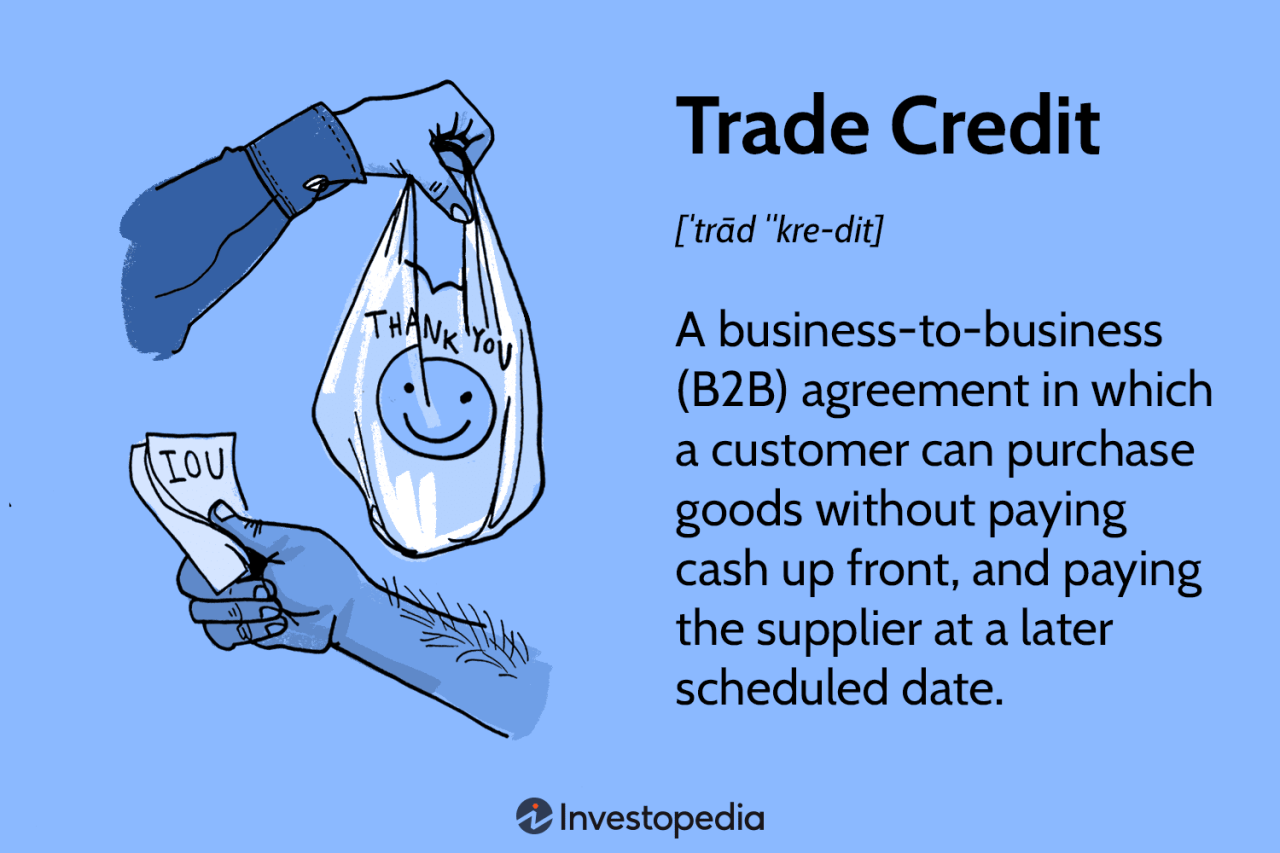Trade credit for small businesses sets the stage for this enthralling narrative, offering readers a glimpse into a story that is rich in detail and brimming with originality from the outset. Imagine a world where businesses, especially small ones, can access funding without the stringent requirements of traditional loans. This is the realm of trade credit, a powerful tool that can fuel growth, enhance cash flow, and foster stronger supplier relationships.
Trade credit, essentially a short-term loan from suppliers, allows businesses to purchase goods and services on credit, deferring payment for a specified period. This can be a game-changer for small businesses, particularly during periods of tight cash flow or when they need to invest in inventory or expansion. By understanding the nuances of trade credit, businesses can leverage its benefits to achieve their financial goals and navigate the complexities of the market.
What is Trade Credit?

Trade credit is a valuable financing option for small businesses, allowing them to purchase goods and services on credit and defer payment for a specified period. It provides a short-term, flexible, and often interest-free way to manage cash flow and invest in growth.
Trade credit differs from traditional financing options such as bank loans or lines of credit. Unlike these options, which typically involve a formal application process, interest payments, and collateral requirements, trade credit is an informal agreement between a business and its suppliers. It’s often based on a simple invoice and a pre-determined payment schedule.
Common Trade Credit Terms
Trade credit terms are typically expressed as “net” followed by a number of days, indicating the payment deadline. For example:
- Net 30: Payment is due 30 days from the invoice date.
- Net 60: Payment is due 60 days from the invoice date.
Other common terms include:
- 2/10, net 30: This means a 2% discount is offered if the invoice is paid within 10 days, otherwise the full amount is due within 30 days.
- EOM: Payment is due at the end of the month following the invoice date.
Benefits of Trade Credit for Small Businesses
Trade credit offers numerous advantages for small businesses, making it a valuable tool for managing finances, strengthening relationships with suppliers, and fostering growth. By understanding these benefits, businesses can leverage trade credit to optimize their operations and achieve their goals.
Improved Cash Flow Management
Trade credit provides small businesses with a critical lifeline for managing their cash flow. By extending payment terms, suppliers allow businesses to acquire goods and services without immediate upfront costs. This flexibility allows businesses to allocate their limited cash resources more strategically, ensuring they can cover essential expenses while investing in growth opportunities. For example, a small bakery might use trade credit to purchase ingredients, allowing them to pay for the goods after they have been sold, ensuring they have enough cash on hand to cover rent and employee wages.
Enhanced Supplier Relationships, Trade credit for small businesses
Trade credit fosters stronger relationships between businesses and their suppliers. By consistently meeting payment obligations, small businesses demonstrate their reliability and trustworthiness, building a foundation for mutual respect and collaboration. This positive rapport can lead to extended payment terms, preferential pricing, and even exclusive access to new products or services. For instance, a small clothing boutique might establish a strong relationship with a wholesale supplier by consistently paying their invoices on time, leading to preferential pricing and early access to new collections.
Business Growth and Expansion
Trade credit can play a crucial role in facilitating business growth and expansion. By providing access to capital without the need for traditional financing, businesses can invest in new inventory, equipment, or marketing initiatives. This allows them to increase production, expand their customer base, and ultimately generate more revenue. For example, a small software development company might use trade credit to purchase new hardware and software, allowing them to develop and release new products, leading to increased market share and profitability.
Risks Associated with Trade Credit

While trade credit offers numerous advantages for small businesses, it’s crucial to understand the potential downsides. Relying heavily on trade credit can expose your business to various risks, impacting your financial health and long-term sustainability.
Late Payments and Their Impact on Cash Flow
Late payments are a significant risk associated with trade credit. When suppliers extend credit, they expect timely repayment. However, delays in payments can disrupt your cash flow, leading to several challenges.
- Reduced Liquidity: Late payments reduce your available cash, making it difficult to meet your own financial obligations, such as rent, salaries, and inventory purchases.
- Missed Investment Opportunities: Insufficient cash flow can hinder your ability to invest in growth initiatives, new equipment, or marketing campaigns, limiting your business’s expansion potential.
- Increased Borrowing Costs: If you need to borrow money to cover cash flow shortages caused by late payments, you may face higher interest rates and additional fees.
- Damaged Credit Score: Repeated late payments can negatively impact your credit score, making it more challenging to secure loans or credit lines in the future.
Implications of Extended Payment Terms on Profitability
While extended payment terms might seem beneficial at first, they can negatively impact your profitability if not managed carefully.
- Delayed Revenue Recognition: When you extend payment terms, you don’t receive revenue immediately, delaying your ability to generate profits and reinvest in your business.
- Increased Costs: Extended payment terms often come with associated costs, such as administrative expenses for managing accounts receivable and potential bad debts.
- Reduced Working Capital: Extended payment terms can reduce your working capital, making it more challenging to manage your day-to-day operations and respond to unexpected expenses.
- Potential for Write-offs: If customers fail to make payments, you may have to write off these debts as bad debts, further impacting your profitability.
Managing Trade Credit Effectively
Managing trade credit effectively is crucial for small businesses to optimize cash flow, maintain healthy relationships with suppliers, and achieve sustainable growth. By implementing strategic approaches to negotiation, tracking, and risk mitigation, businesses can leverage trade credit to their advantage.
Negotiating Favorable Trade Credit Terms
Negotiating favorable trade credit terms involves understanding the leverage you hold as a buyer and knowing how to present a compelling case for extended payment terms. Here are some key strategies:
- Build a Strong Relationship: Cultivate a positive relationship with suppliers by consistently paying invoices on time and demonstrating your commitment to long-term partnership. This builds trust and increases your negotiation leverage.
- Leverage Your Business Performance: Highlight your business’s financial health, growth trajectory, and strong payment history. These factors demonstrate your ability to meet financial obligations and justify extended terms.
- Explore Options: Discuss different payment options with suppliers, such as early payment discounts or flexible payment schedules, to find terms that benefit both parties.
- Negotiate in Bulk: Consider placing larger orders to secure more favorable terms, such as longer payment periods or volume discounts.
- Be Prepared to Walk Away: If a supplier is unwilling to offer acceptable terms, be prepared to explore alternative options, such as finding a different supplier or sourcing materials elsewhere.
Tracking Outstanding Invoices and Payments
Maintaining a robust system for tracking outstanding invoices and payments is essential for managing cash flow and preventing late payments.
- Implement an Invoice Management System: Use software or a spreadsheet to track all invoices, including due dates, payment terms, and payment status. This provides a centralized view of outstanding obligations.
- Set Payment Reminders: Automate payment reminders to be sent out before due dates to avoid late payments and maintain good relationships with suppliers.
- Reconcile Accounts Regularly: Regularly compare your records with supplier statements to ensure accuracy and identify any discrepancies that may require further investigation.
- Communicate Proactively: If you anticipate a delay in payment, communicate with your suppliers promptly and explain the situation. This transparency fosters understanding and prevents potential issues.
Minimizing the Risk of Bad Debt
Bad debt can significantly impact a small business’s financial stability. To mitigate this risk:
- Conduct Thorough Due Diligence: Before extending credit, thoroughly investigate the creditworthiness of new customers. This includes checking their credit history, financial statements, and industry reputation.
- Set Clear Credit Limits: Establish credit limits for customers based on their financial capacity and risk profile. This helps control exposure to potential bad debt.
- Implement a Collection Policy: Develop a clear and consistent collection policy that Artikels procedures for handling overdue payments. This includes sending follow-up reminders, initiating collection calls, and, if necessary, pursuing legal action.
- Offer Incentives for Early Payment: Encourage timely payments by offering discounts or other incentives for customers who pay their invoices early. This can improve cash flow and reduce the risk of bad debt.
Trade Credit and Business Growth
Trade credit is a powerful tool that can fuel the growth of small businesses. It provides a flexible and accessible source of funding, allowing companies to invest in expansion, manage inventory effectively, and seize new market opportunities.
Facilitating Expansion and Inventory Management
Trade credit can significantly impact a small business’s ability to expand operations and manage inventory efficiently. By extending payment terms, suppliers enable businesses to acquire essential resources without immediate cash outlay. This frees up working capital for other critical business activities, such as investing in new equipment, hiring additional staff, or expanding into new markets.
For instance, a small retailer might utilize trade credit to purchase a larger inventory of seasonal products. By deferring payment, the retailer can stock up on goods without depleting its cash reserves, ensuring sufficient merchandise to meet increased demand during peak seasons.
Accessing New Markets and Opportunities
Trade credit can play a crucial role in helping small businesses enter new markets and explore growth opportunities. By providing flexible payment terms, suppliers can make it easier for businesses to establish themselves in unfamiliar territories. This is particularly beneficial for companies seeking to expand their customer base or diversify their product offerings.
Consider a small manufacturing company looking to expand its operations into a new geographic region. By securing trade credit from suppliers in the target market, the company can acquire the necessary raw materials and components without substantial upfront investment. This allows the business to focus on building relationships with local customers and establishing a foothold in the new market.
Supporting the Development of New Products or Services
Trade credit can also be a valuable asset for small businesses developing new products or services. By extending payment terms, suppliers can provide the financial flexibility needed to fund research and development initiatives. This allows businesses to experiment with innovative ideas and bring new offerings to market without significant financial strain.
Imagine a small technology startup developing a groundbreaking software application. Trade credit from component suppliers can enable the company to acquire the necessary hardware and software licenses to build and test its product. This financial support can be crucial in bringing the innovation to market and securing a competitive advantage.
Trade Credit in the Digital Age
The digital revolution has profoundly impacted the way businesses operate, and trade credit is no exception. Online platforms have transformed how businesses access and manage trade credit, leading to increased efficiency, transparency, and accessibility. Fintech solutions have emerged to streamline processes and offer innovative ways to manage trade credit, enhancing its value proposition for small businesses.
Impact of Online Platforms on Trade Credit Access
Online platforms have revolutionized trade credit access for small businesses by providing them with a wider range of options and streamlining the application process.
- Increased Accessibility: Online platforms have made it easier for small businesses to access trade credit from a broader range of lenders, including non-traditional players like fintech companies. This has expanded their options and increased their chances of securing financing.
- Simplified Application Process: Online platforms often have streamlined application processes that require less paperwork and documentation, making it faster and easier for small businesses to apply for trade credit. This allows them to access funds more quickly and efficiently.
- Improved Transparency: Online platforms provide greater transparency in terms of interest rates, fees, and terms and conditions. This allows small businesses to compare different offers and make informed decisions about which trade credit option is best suited for their needs.
Fintech Solutions for Managing Trade Credit
Fintech companies have developed innovative solutions that help small businesses manage their trade credit more effectively.
- Automated Invoice Processing: Fintech platforms automate invoice processing, reducing manual errors and streamlining the entire process. This allows businesses to receive payments faster and manage their cash flow more efficiently.
- Real-Time Credit Monitoring: Fintech solutions provide real-time monitoring of credit limits, outstanding invoices, and payment histories, allowing businesses to proactively manage their credit exposure and mitigate risks.
- Dynamic Credit Scoring: Fintech platforms use advanced algorithms to assess creditworthiness based on real-time data, allowing for more accurate and dynamic credit scoring. This enables businesses to access credit based on their current financial performance rather than relying on traditional credit history.
Future Trends and Challenges of Trade Credit in the Digital Economy
The future of trade credit in the digital economy is likely to be characterized by continued innovation and evolving challenges.
- Increased Use of AI and Machine Learning: AI and machine learning are expected to play a significant role in trade credit management, automating tasks, improving risk assessment, and personalizing credit offers.
- Growth of Alternative Credit Scoring: Alternative credit scoring methods based on non-traditional data sources, such as social media activity and online transactions, are likely to gain prominence. This will expand access to credit for businesses that may not have a strong traditional credit history.
- Cybersecurity Concerns: As trade credit management becomes increasingly digital, cybersecurity will become a major concern. Businesses need to invest in robust security measures to protect their data and prevent fraud.
- Regulatory Landscape: The regulatory landscape for trade credit is evolving, with new rules and regulations being introduced to address issues such as data privacy and consumer protection. Businesses need to stay informed about these changes and ensure they comply with all applicable regulations.
Last Recap

In the dynamic landscape of modern business, trade credit emerges as a valuable tool for small businesses to thrive. By embracing its benefits, understanding its risks, and managing it effectively, entrepreneurs can unlock opportunities for growth, navigate cash flow challenges, and strengthen supplier relationships. As the digital age continues to reshape commerce, trade credit is poised to play an even more prominent role, offering innovative solutions and fostering a more equitable playing field for small businesses.
Essential FAQs: Trade Credit For Small Businesses
What are the typical payment terms for trade credit?
Common trade credit terms include net 30, net 60, and net 90, which indicate the number of days a business has to pay its invoice. For example, net 30 means the payment is due 30 days after the invoice date.
How can I improve my chances of getting approved for trade credit?
Establish a good credit history, maintain a strong track record of on-time payments, and demonstrate a solid financial standing. Building relationships with suppliers and demonstrating your commitment to their products or services can also be beneficial.
What are some common pitfalls to avoid when using trade credit?
Avoid over-reliance on trade credit, as it can lead to cash flow problems if not managed properly. Always carefully review the terms and conditions, and ensure you understand the potential consequences of late payments.
 Norfolk Publications Publications ORG in Norfolk!
Norfolk Publications Publications ORG in Norfolk!

